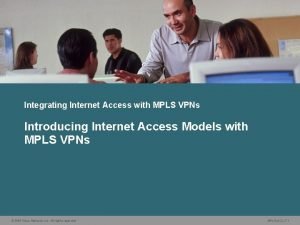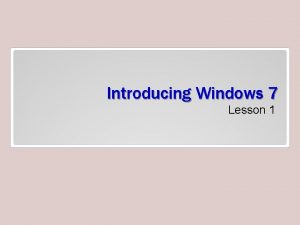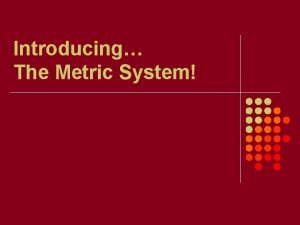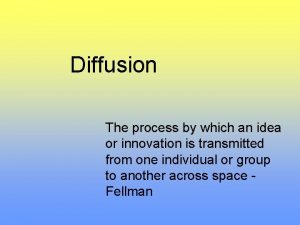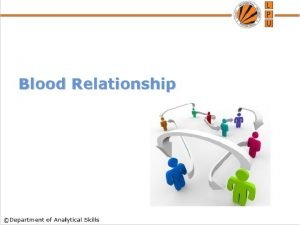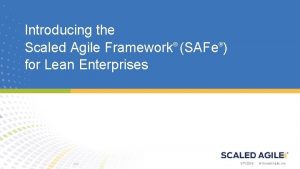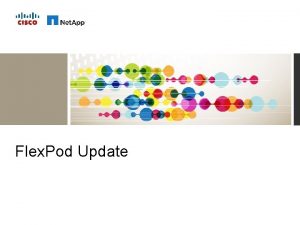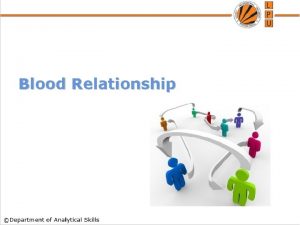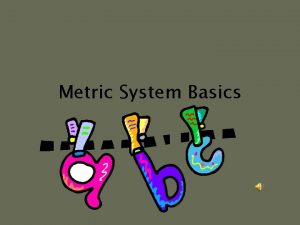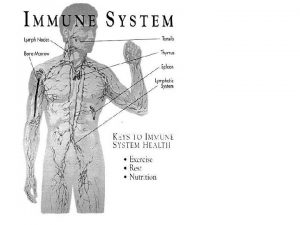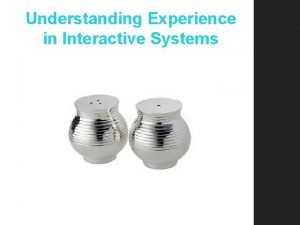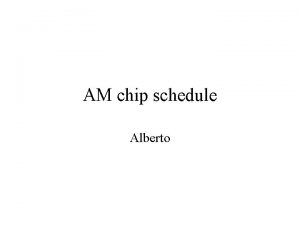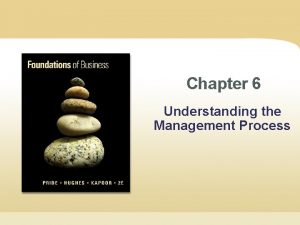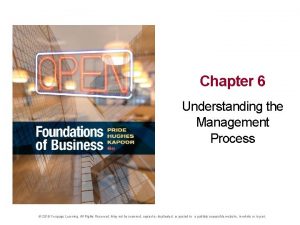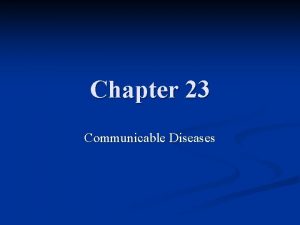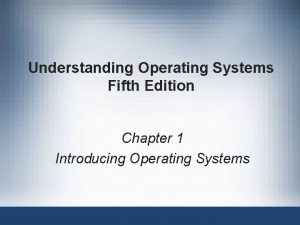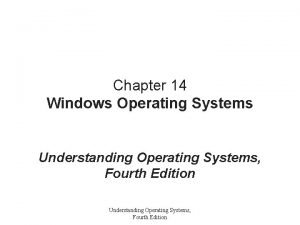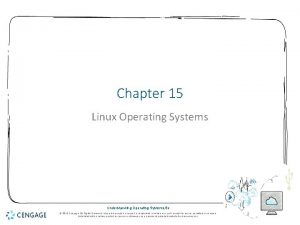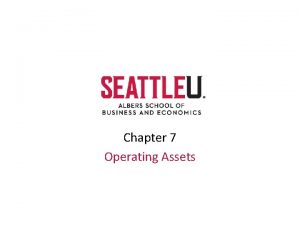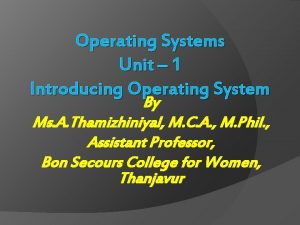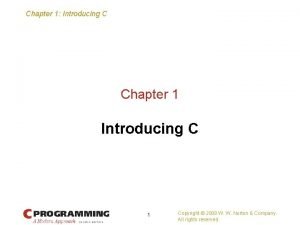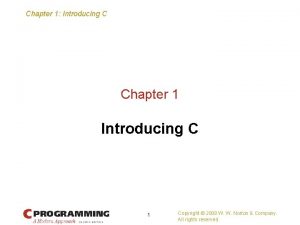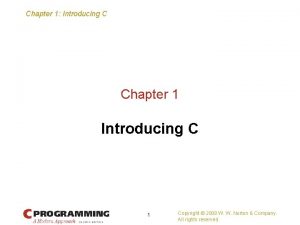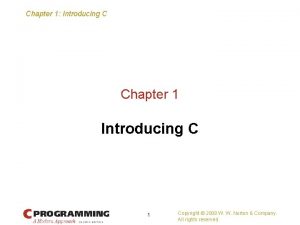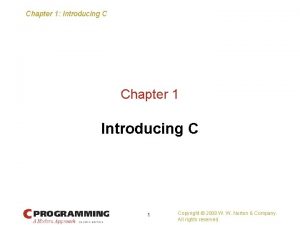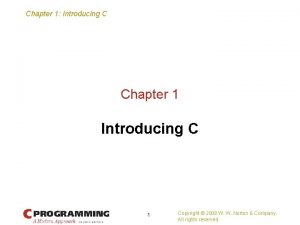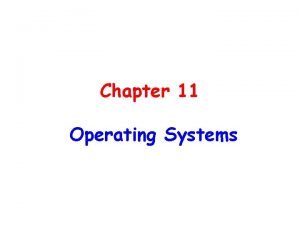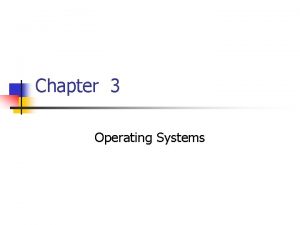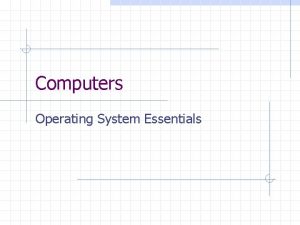Chapter 1 Introducing Operating Systems Understanding Operating Systems


















































- Slides: 50

Chapter 1 Introducing Operating Systems Understanding Operating Systems, Fourth Edition

Objectives You will be able to describe: • The basic role of an operating system • The major operating system software subsystem managers and their functions • The types of machine hardware on which operating systems run, and give at least one example of an operating system for each of the following: PDAs, microcomputers, minicomputers, mainframes, workstations, and supercomputers Understanding Operating Systems, Fourth Edition 2

Objectives (continued) Describe: • The differences between the following types of operating systems: batch, interactive, real-time, hybrid, and embedded • Multiprocessing and its impact on the evolution of operating system software • System architecture trends in current operating systems Understanding Operating Systems, Fourth Edition 3

Understanding Operating Systems “I think there is a world market for maybe five computers. ”—Thomas J. Watson (1874– 1956; chairman of IBM 1949– 1956) Understanding Operating Systems, Fourth Edition 4

What is an Operating System? • Operating System: – Part of the computing system that manages all of the hardware and software – Controls every file, every device, every section of main memory, and every nanosecond of processing time – Controls who can use the system and how • Computer system consists of: – Software (programs) – Hardware (the physical machine and its electronic components) Understanding Operating Systems, Fourth Edition 5

Operating System Software • Essential managers of an operating system: – – Memory Manager Processor Manager Device Manager File Manager • Each manager both works closely with the other managers and performs its unique role • User Command Interface is unique to each operating system Understanding Operating Systems, Fourth Edition 6

Operating System Software (continued) Figure 1. 1: Model of a non-networked operating system Understanding Operating Systems, Fourth Edition 7

Operating System Software (continued) • Each subsystem manager must perform the following tasks: – Monitor its resources continuously – Enforce the policies that determine who gets what, when, and how much – Allocate the resource when it’s appropriate – Deallocate the resource when appropriate Understanding Operating Systems, Fourth Edition 8

Operating System Software (continued) Figure 1. 2: Subsystems managers at the base of a pyramid Understanding Operating Systems, Fourth Edition 9

Operating System Software (continued) • Memory Manager: In charge of main memory (RAM) • Responsibilities include: – Preserves the space in main memory occupied by the operating system – Checks the validity of each request for memory space – Sets up a table to keep track of who is using which section of memory in a multiuser environment – Deallocates memory when the time comes to reclaim the memory Understanding Operating Systems, Fourth Edition 10

Operating System Software (continued) • Processor Manager decides how to allocate the central processing unit (CPU) • Processor Manager has two levels of responsibility: – To handle jobs as they enter the system • Handled by Job Scheduler – To manage each process within those jobs • Handled by Process Scheduler Understanding Operating Systems, Fourth Edition 11

Operating System Software (continued) • Device Manager monitors every device, channel, and control unit • Responsibilities include: – Chooses the most efficient way to allocate all of the system’s devices, printers, terminals, disk drives, based on a scheduling policy – Makes the allocation, starts its operation – Deallocates the device Understanding Operating Systems, Fourth Edition 12

Operating System Software (continued) • File Manager keeps track of every file in the system including data files, assemblers, compilers, and application programs • Responsibilities include: – Enforces restrictions on who has access to which files by using predetermined access – Controls what users are allowed to do with files once they access them – Allocates the resource by opening the file and deallocates it by closing the file Understanding Operating Systems, Fourth Edition 13

Operating System Software (continued) • Operating systems with networking capability have a fifth essential manager called the Network Manager • Network Manager provides a convenient way for users to share resources while controlling users’ access to them. The resources include: – Hardware (such as CPUs, memory areas, printers, tape drives, modems, and disk drives) – Software (such as compilers, application programs, and data files) Understanding Operating Systems, Fourth Edition 14

Operating System Software (continued) Figure 1. 3: Model of a networked operating system Understanding Operating Systems, Fourth Edition 15

Machine Hardware • Essential hardware components include: – – Memory chips Input/output devices Storage devices Central processing unit (CPU) Understanding Operating Systems, Fourth Edition 16

Machine Hardware (continued) Figure 1. 4: Computer system hardware configuration Understanding Operating Systems, Fourth Edition 17

Machine Hardware (continued) • Until mid-1970 s, computers were classified by capacity and price • A mainframe was a large machine—in size and in internal memory capacity – In 1964, IBM 360 model 30 required an airconditioned room (18 feet square) to house the CPU – The CPU was five feet high and six feet wide, had an internal memory of 64 K – A price tag of $200, 000 in 1964 dollars. – Applications limited to large computer centers Understanding Operating Systems, Fourth Edition 18

Machine Hardware (continued) • Minicomputer was developed to meet the needs of smaller institutions • Digital Equipment Corporation marketed one of the early minicomputers • Price was less than $18, 000 • Minicomputers are smaller in size and memory capacity, and cheaper than mainframes. • Today, computers that fall between microcomputers and mainframes in capacity are often called midrange computers Understanding Operating Systems, Fourth Edition 19

Machine Hardware (continued) • Supercomputer was introduced for military operations and weather forecasting – Example: A Cray supercomputer with six to thousands of processors performing up to 2. 4 trillion floating point operations per second (teraflops) • Supercomputer’s uses include wide range of tasks from scientific research to customer support and product development Understanding Operating Systems, Fourth Edition 20

Machine Hardware (continued) • Microcomputer was developed for single users in the late 1970 s • Tandy Corporation and Apple Computer, Inc. were the first to offer microcomputers • These early models had very little memory by today’s standards— 64 K maximum capacity • The distinguishing characteristic of a microcomputer is its single-user status Understanding Operating Systems, Fourth Edition 21

Machine Hardware (continued) • Workstations: Most powerful microcomputers used by commercial, educational, and government enterprises • Workstations are networked together and used to support engineering and technical users who perform: – Massive mathematical computations – Computer-aided design (CAD) – Applications requiring powerful CPUs, large main memory, and extremely high-resolution graphic displays Understanding Operating Systems, Fourth Edition 22

Machine Hardware (continued) • Advances in computer technology – Dramatic changes in physical size, cost, and memory capacity – Networking is an integral part of modern computer systems – Delivering information to a mobile society, creating a strong market for handheld devices – Classified by processor capacity instead of memory capacity – Computing power rises exponentially — Moore’s Law Understanding Operating Systems, Fourth Edition 23

Machine Hardware (continued) Table 1. 1: Different platforms and operating systems Understanding Operating Systems, Fourth Edition 24

Types of Operating Systems (continued) • Operating systems for computers fall into following five categories: – – – Batch Interactive Real-time Hybrid Embedded • Distinguished by response time and how data is entered into the system Understanding Operating Systems, Fourth Edition 25

Types of Operating Systems (continued) • Batch Systems: – Relied on punched cards or tape for input in past – Efficiency of the system was measured in throughput • Interactive Systems: – Gives a faster turnaround than batch systems but are slower than the real-time systems – Introduced for users who needed fast turnaround when debugging their programs – Operating system required the development of time sharing software Understanding Operating Systems, Fourth Edition 26

Types of Operating Systems (continued) • Real-time systems: – Fastest and used in time-critical environments – Real-time systems are used for: • • • Space flights, airport traffic control, high-speed aircraft Industrial processes Sophisticated medical equipment Distribution of electricity Telephone switching – A real-time system must be 100 percent responsive, 100 percent of the time Understanding Operating Systems, Fourth Edition 27

Types of Operating Systems (continued) Figure 1. 5: Computer interface box for the Apollo spacecraft (1968) Understanding Operating Systems, Fourth Edition 28

Types of Operating Systems (continued) • Hybrid Systems: – Combination of batch and interactive – Accepts and runs batch programs in the background when the interactive load is light • Embedded Systems: – Computers placed inside other products to add features and capabilities – Operating systems with small kernel and flexible functions capabilities will have potential for embedded system Understanding Operating Systems, Fourth Edition 29

Brief History of Operating Systems Development • 1940 s: – Computers based on vacuum tube technology – No standard operating system software – Typical program included every instruction needed by the computer to perform the tasks requested – Machines were poorly utilized • CPU processed data and made calculations for only a fraction of the available time – Early programs were designed to use the resources conservatively at the expense of understandability Understanding Operating Systems, Fourth Edition 30

Brief History of Operating Systems Development (continued) Figure 1. 6: Remains of the first computer “bug, ” a moth Understanding Operating Systems, Fourth Edition 31

Brief History of Operating Systems Development (continued) • 1950 s: – Placed importance on cost effectiveness – Computers were still very expensive • IBM 7094 was priced at $200, 000 – Two improvements were widely adopted • Computer operators were hired to facilitate each machine’s operation • Concept of job scheduling—groups together programs with similar requirements – Expensive time lags between CPU and I/O devices Understanding Operating Systems, Fourth Edition 32

Brief History of Operating Systems Development (continued) Figure 1. 7: The IBM 650 Magnetic Drum Data Processing System Machine Understanding Operating Systems, Fourth Edition 33

Brief History of Operating Systems Development (continued) • Factors that improved the performance of CPU: – Speed of I/O devices like tape drives, disks, and drums gradually became faster – Records were blocked before they were retrieved or stored – Access methods were developed and added to object code by the linkage editor – Buffer was introduced between I/O and the CPU to reduce the discrepancy in speed – Timer interrupts were developed to allow job-sharing Understanding Operating Systems, Fourth Edition 34

Brief History of Operating Systems Development (continued) • 1960 s: – Faster CPUs, but their speed caused problems – Multiprogramming was introduced, which allowed loading many programs at one time – Program scheduling, which was begun with secondgeneration systems, continued at this time – Few advances were made in data management – Total operating system was customized to suit user’s needs Understanding Operating Systems, Fourth Edition 35

Brief History of Operating Systems Development (continued) • 1970 s: – Faster CPUs, but their speed caused problems – Multiprogramming schemes to increase CPU use were limited by physical capacity of main memory • Development of virtual memory to solve physical limitation issue – Database management software became a popular tool – A number of query systems were introduced – Programs started using English-like words, modular structures, and standard operations Understanding Operating Systems, Fourth Edition 36

Brief History of Operating Systems Development (continued) Figure 1. 8: Cray I supercomputer, introduced in 1976 Understanding Operating Systems, Fourth Edition 37

Brief History of Operating Systems Development (continued) • 1980 s: – Improvement in the cost/performance ratio of computer components – Hardware became more flexible – Introduction of multiprocessing, which allowed executing programs in parallel – Evolution of personal computers and high-speed communications – Introduction of distributed processing and networked systems Understanding Operating Systems, Fourth Edition 38

Brief History of Operating Systems Development (continued) • 1990 s: – Demand for Internet capability sparked the proliferation of networking capability – Increased networking also created increased demand for tighter security to protect hardware and software – Multimedia applications, demanding additional power, flexibility, and device compatibility for most operating systems Understanding Operating Systems, Fourth Edition 39

Brief History of Operating Systems Development (continued) Figure 1. 9: Linked information system by Tim Berners-Lee Understanding Operating Systems, Fourth Edition 40

Current Operating Systems • Primary design features of current operating systems are based on providing support for – Multimedia applications – Internet and Web access – Client/server computing • Computer systems are required to have – Increased CPU speed – High-speed network attachments – Increased number and variety of storage devices Understanding Operating Systems, Fourth Edition 41

System Architecture • Improvements in system architecture – Use of object-oriented design • Possible to modify and customize pieces of an operating system without disrupting the integrity of the remainder of the system • Makes software development groups more productive – Reorganization of the operating system’s kernel • Limited to a few essential functions Understanding Operating Systems, Fourth Edition 42

System Architecture (continued) Figure 1. 10: (a) Early operating systems; (b) & (c) Modern object-oriented systems Understanding Operating Systems, Fourth Edition 43

Threads • Thread: A portion of a program that can run independently of other portions – The heavyweight process which owns the resources becomes a more passive element – Thread becomes the element that uses the CPU and is scheduled for execution – Swapping threads is less time consuming than swapping processes • Multithreaded applications programs can have several threads running at one time with the same or different priorities Understanding Operating Systems, Fourth Edition 44

Multiprocessing Configurations • Symmetric multiprocessing: – Allows for several CPUs to process multiple jobs at the same time – CPUs are independent of one another, but each has access to the operating system • Asymmetric multiprocessing: – Some operating systems functions are assigned to subordinate processors, which take their instructions from the main CPU Understanding Operating Systems, Fourth Edition 45

Multiprocessing Configurations (continued) Figure 1. 11: Symmetric multiprocessing system with five processors Understanding Operating Systems, Fourth Edition 46

Multiprocessing Configurations (continued) • Network PCs gave impetus to the concept of distributed processing – Processors are placed at remote locations and are connected to each other via telecom devices – Different from symmetric multiprocessing systems as they do not share memory – Computations can be dispersed among several processors – Overall capability of the computer system is maximized Understanding Operating Systems, Fourth Edition 47

Summary • Operating System manages all of the hardware and software of a computer system • Each manager of an OS both works closely with the other managers and performs its unique role • Operating systems with networking capability have Network Manager • Essential hardware components include memory chips, I/O, storage devices and CPU • Until mid-1970 s, computers were classified by capacity and price Understanding Operating Systems, Fourth Edition 48

Summary (continued) • Computing power has been rising exponentially— Moore’s Law • Dramatic changes in physical size, cost, and memory capacity with time • Networking has become an integral part of modern computer systems • Delivering information to a mobile society, creating a strong market for handheld devices • Operating systems fall into following five categories: batch, interactive, real-time, hybrid and embedded Understanding Operating Systems, Fourth Edition 49

Summary (continued) • Use of object-oriented design improved the system architecture • Symmetric multiprocessing allows for several CPUs to process multiple jobs at the same time • Network PCs gave impetus to the concept of distributed processing Understanding Operating Systems, Fourth Edition 50
 Types of operating system
Types of operating system Define politics
Define politics Operational definition in psychology
Operational definition in psychology What is the purpose of a signal phrase
What is the purpose of a signal phrase Rowe concise introduction to linguistics download
Rowe concise introduction to linguistics download 1941-1882
1941-1882 Quote explanation sentence starters
Quote explanation sentence starters Counterclaim in writing
Counterclaim in writing Introduce yourself interview
Introduce yourself interview How to introduce yourself in training session
How to introduce yourself in training session Introducing family members in french
Introducing family members in french Poetic devices
Poetic devices Intro
Intro Introducing
Introducing Introducing integers
Introducing integers Mpls internet access
Mpls internet access Explanation sentence starters
Explanation sentence starters Introducing new market offerings
Introducing new market offerings As he himself puts it the art of quoting summary
As he himself puts it the art of quoting summary Define upgrade advisor
Define upgrade advisor Khdmdcm calculator
Khdmdcm calculator How to write a good short bio
How to write a good short bio Stimulus diffusion definition
Stimulus diffusion definition A blood relationship
A blood relationship An introduction to the odyssey
An introduction to the odyssey A letter to exchange student
A letter to exchange student Introducing broker vs carrying broker
Introducing broker vs carrying broker Int family
Int family Introducing the scaled agile framework
Introducing the scaled agile framework Introducing flex pods
Introducing flex pods Expression leave taking and response
Expression leave taking and response Introducing neeta anil said
Introducing neeta anil said Introducing rhetoric using the available means
Introducing rhetoric using the available means Templates for introducing quotations
Templates for introducing quotations Templates for introducing quotations
Templates for introducing quotations What's the metric system
What's the metric system Introducing yourself
Introducing yourself Introducing quotes words
Introducing quotes words Introducing illustrator 2013 download
Introducing illustrator 2013 download The purpose of introducing weakened microbes
The purpose of introducing weakened microbes Introducing and naming new products and brand extensions
Introducing and naming new products and brand extensions Introducing and naming new products and brand extensions
Introducing and naming new products and brand extensions Ariel introducing a
Ariel introducing a Understanding experience in interactive systems
Understanding experience in interactive systems Amchip
Amchip Chapter 9 lesson 3 understanding violence
Chapter 9 lesson 3 understanding violence Understanding the scriptures chapter 24 study questions
Understanding the scriptures chapter 24 study questions Chapter 6 understanding the management process
Chapter 6 understanding the management process Chapter 6 understanding the management process
Chapter 6 understanding the management process Understanding supply section 1
Understanding supply section 1 Chapter 23 lesson 1 understanding communicable diseases
Chapter 23 lesson 1 understanding communicable diseases















